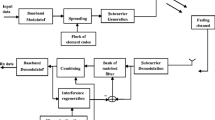Abstract
In this paper, we propose a multitone code-division multiple-access (MT-CDMA) system employing antenna array at base station with quaternary phase shift keying modulation (QPSK) modulation. Based on the detailed analysis of interference characteristics the BER performance of the proposed MT-CDMA system is provided. With regard to spatial domain combining, the optimum and suboptimum combining weight is derived while the suboptimum set of weights is simplified on sense of that only the knowledge of array vector of desired user alone is sufficient for the optimum combining. Simulation results verify the analysis and show that better performance is achieved for the proposed antenna array system than single antenna MT-CDMA approach.
Similar content being viewed by others
References
Prasad R., Hara S. (1997)“An Overview of Multi-carrier CDMA”. IEEE Commun Mag. 35(12): 126–133
Kondo S., Milstein L.B. (1996) “Performance of Multicarrier DS CDMA system”. IEEE Trans Commun. 44(2): 238–246
Q. M. Rahman and A. B. Sesay, “Performance Analysis of MT-CDMA System with Diversity Combining”, in MILCOM’2001, pp. 1360–1364, 2001.
Q. M. Rahman and A. B. Sesay, “Blind Joint Equalization and Multiuser Detection in Dispersive MC-CDMA/MC-DS-CDMA/MT-CDMA Channels”, in MILCOM’2002, pp. 814–819, 2002.
Li C., zhuang W. (2002) “Hybrid TDOA/AOA Mobile User Location for Wideband CDMA Cellular Systems”. IEEE Trans. Wireless Commun 1(3): 439–447
W. Yang and S. X. Cheng, “A Cumulant Based DOA Estimation for S-CDMA with Decorrelator in Spatial Colored Noise”, in ISSSTA’2002, pp. 566–570, 2002.
Naguib A.F., Paulraj A. (1996) “Performance of Wireless CDMA with M-ary Orthogonal Modulation and Cell Site Antenna Arrays”. IEEE J. Select. Areas Commun 14(9): 1770–1783
Anna M.D., Aghvami A.H. (1999)“Performance of Optimum and Suboptimum Combining at the Antenna Array of a W-CDMA System”. IEEE J. Select. Areas Commun 17(12): 2123–2137
Kim K., Cho Y.S. (2000) “Performance of MC-CDMA System with an Antenna Array in a Fading Channel: Reverse link”. IEEE Trans. Commun 48(8): 1257–1261
Torrieri D.J. (1992) “Performance of Direct-Sequence Systems with Long Pseudonoise Sequences”. IEEE J. Select. Areas Commun 10(4): 770–781
J. Salz and J. H. Winters, “Effect of Fading Correlation on Adaptive Arrays in Digital Wireless Communications”, in ICC’93, pp. 1768–1774, 1993.
O. Nørklit, P. Eggers, P. Zetterberg, and J. B. Andersen, “The Angular Aspect of Wideband Modelling and Measurements”, in ISSSTA’96, pp. 73–78, 1996.
J. C. Liberti, “Measuring and Modeling Spatial Radio Channels for Smart Antenna Systems”, in AP’1998, pp. 635–638, 1998.
S. Haykin, Adaptive Filter Theory, Prentice-hall, Inc., 1996.
J. G. Proakis, Digital Communications, McGraw-Hill, 1995.
Author information
Authors and Affiliations
Corresponding author
Rights and permissions
About this article
Cite this article
Yang, W., Liu, J., Chen, J. et al. Performance Analysis of MT-CDMA System with Antenna Array in a Multipath Fading Channel. Wireless Pers Commun 41, 427–446 (2007). https://doi.org/10.1007/s11277-006-9151-5
Published:
Issue Date:
DOI: https://doi.org/10.1007/s11277-006-9151-5




